By Jennifer Kornegay
The Alabama Tourism Department’s “100 Dishes to Eat Before You Die” round-up presents some of the tastiest bites being served at restaurants around Alabama. But while our state has no shortage of locations to enjoy a delicious meal out, we’ve also got a hefty helping of outstanding home cooks. For our kitchen wiz readers, we’ve created another Alabama-food-focused collection. We enlisted the help of several Alabama food aficionados (chefs and restaurant owners, writers and a foodways expert) and asked them to share their picks for dishes that Alabama cooks ought to have in their recipe repertoire.
Read on for the Essential Alabama Dishes list we compiled with their input. But note: We’re not claiming these are our state’s only powerful or popular foods; they’re just a few mouthfuls out of a deep and wide pot. Also note: We don’t think you should make these dishes just sometime before you die; we think you should find an appealing recipe in one of your cookbooks, (or get on Google) and get cookin’ right now!
Cornbread
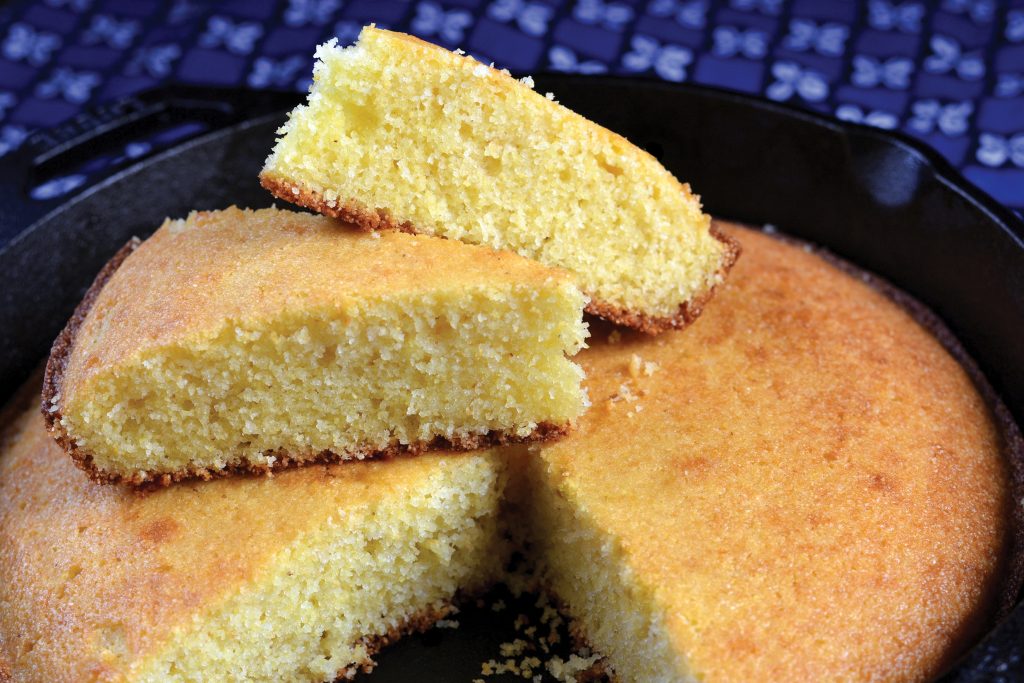
In 2014, cornbread was finally and officially elevated to the place of prominence it has long held in many a Southern food lover’s heart (and stomach). That year, it became Alabama’s state bread, beating even the showy biscuit for the title. And yet, it’s still a humble dish, relatively cheap and uncomplicated to make, rarely adorned with more than butter.
The hardest part may be deciding which version of cornbread to go with. There’s more than one type, and some debates on what constitutes “authentic” cornbread can get as hot as the cast iron skillet your grandmother used for hers, but for our purposes, we’re including any kind with cornmeal as the majority grain.
Bob Carlton, a veteran journalist who writes about food for AL.com, This is Alabama and The Birmingham News, included cornbread on his list of iconic Alabama foods along with an admonishment for those who are cornbread-challenged. “If you don’t already know how to cook cornbread, you need to rectify that situation right now,” he says. “A wedge of hot-out-the-skillet cornbread smeared with a melting pat of butter brings back memories of my childhood, and no home-cooked Sunday dinner is complete without it.”
His mention of how memory can factor mightily in the foods we cherish mixes well with Lisa Thomas-McMillan’s thoughts on a different kind of cornbread, the fried cornbread fritters that topped her list of essential Alabama dishes. The owner of Drexell & Honeybee’s in Brewton — a “pay what you can” restaurant feeding the needs of its community (featured in the Dec. 2018 issue of Alabama Living) — believes that fritters often draw curious diners precisely because they’re a bit different from what some are used to. “Just the idea that it is not a muffin or a hunk of cornbread makes people anxious to try fried cornbread fritters,” she said.
West Indies Salad
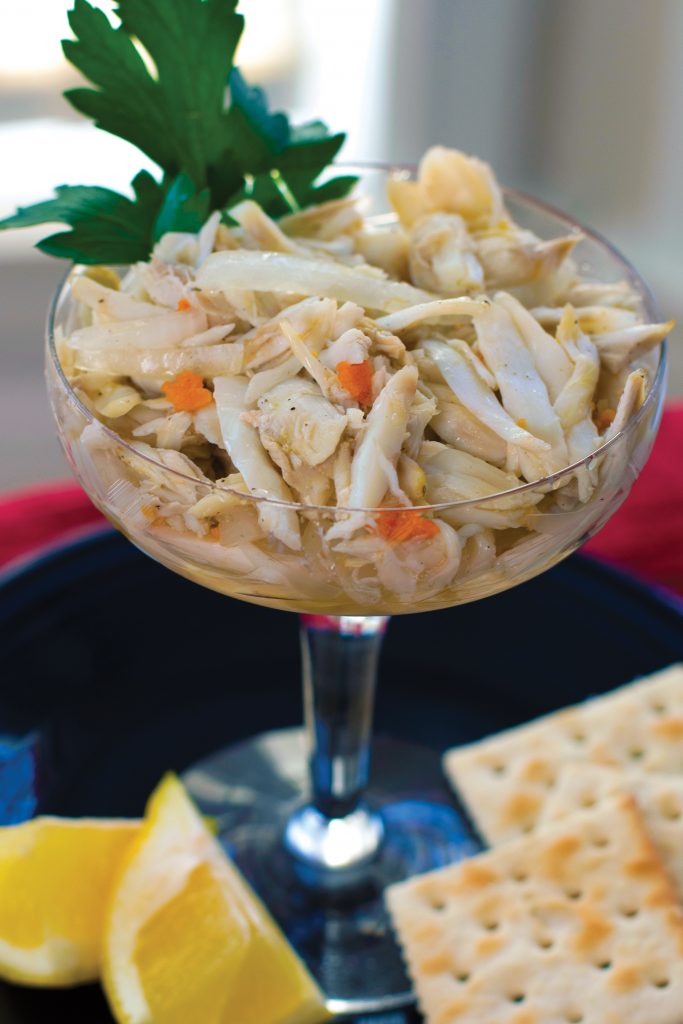
You can make a diverse array of dishes with fresh Gulf coast crabs: fried and sautéed crab claws, crab cakes, herb-laden crab stuffing and creamy crab bisque. But to enjoy this saltwater species in a more unadulterated form, you want West Indies Salad. This simple but scrumptious delight — mounds of silken crabmeat lightly embellished with vinegar, onion and oil — is a uniquely Alabama item, having been created at Bayley’s Seafood Restaurant in Theodore (right outside Mobile) in the late 1940s.
According to chef Jim Smith, owner of Mobile’s The Hummingbird Way and former executive chef for the State of Alabama, West Indies Salad is the dish that immediately comes to his mind when asked, “What should any cooking Alabamian know how to make?” “Alabama crab is such a great ingredient and always a show-stopper,” he says. “West Indies Salad was created in Theodore and highlights the sweetness and delicate nature of Alabama crab.” He noted it can be enjoyed with nothing but crackers or as an accompaniment to other dishes, like a green salad or gazpacho.
Lucy Buffett – coastal Alabama native, chef, cookbook author and owner of Lulu’s restaurant in Gulf Shores – agreed with Smith, calling West Indies Salad a “quintessential” Alabama dish. Like Carlton and cornbread, Buffett has a personal affinity for this food. “An Alabamian came up with it, so that’s an important thing,” she says. “But for me, it’s just been a part of my life since I was a kid.”
Her parents took her and her siblings (including famous musician Jimmy) to Bayley’s when she was growing up. Both her grandmothers routinely whipped it up at home. “They were great cooks!” she said. “My mom, not so much, but she could make West Indies Salad. I learned from them; it was one of the first dishes I made when I started cooking. And it’s the recipe that I make for my siblings when they come to visit. That’s what they want; it tastes of home.”
Lulu’s West Indies Salad
Makes 4-6 Servings
(reprinted with permission)
- 1 pound fresh jumbo lump blue crab meat
- ¼ to ½ cup medium Vidalia (or sweet) onion, sliced paper thin, in half moon shape
- 1/3 cup vegetable oil
- 1/3 cup white vinegar
- *Important: 4-5 ice cubes placed in a measuring cup, then filled to 1/3 cup with cold water
- 1 teaspoon Kosher salt, divided
- ½ teaspoon freshly ground black pepper, divided
Place half of the crabmeat gently on the bottom of a glass bowl or plastic container. Sprinkle ½ teaspoon of salt and ¼ teaspoon of pepper.
Cover crab with a layer of onion.
Repeat these steps with remaining crab, onion, salt and pepper.
Pour oil, vinegar, ice water and ice cubes over crab. Cover and marinate for at least two hours.
When ready to serve, shake bowl gently or if using a seal-proof plastic container turn upside down and back upright to gently mix salad.
Correct seasonings. Serve with saltine crackers.
LuLu Clue 1: It really is this easy, and the ice cubes are crucial. Don’t ask me why, but when I haven’t included them, the dish just doesn’t taste the same.
LuLu Clue 2: I use jumbo lump even though it is expensive. You can use regular lump crab, but you must carefully and delicately pick through it for shells.
Lane Cake

In stark contrast to a cobbler or West Indies Salad, the Lane Cake takes some serious kitchen skills. This layered dessert is labor intensive, but those lucky enough to have tasted it say it’s all worth it. Chef Smith calls it a dish all Alabamians “should be proud of” when explaining its place on his list of essential dishes. “This cake was invented in Alabama by Emma Rylander Lane in Clayton in the 1890s, and she won many awards for it in her time. The cake is also famously mentioned in ‘To Kill A Mockingbird.’”
His rendition of the classic is a chiffon cake topped with an icing that’s heavily spiked with bourbon, plus pecans, coconut and raisins. “The Lane Cake is always a conversation starter and is a great cake for Alabamians to make at home,” Smith says. Like several of the other foods on our list, the Lake Cake is also “certified Alabama;” it’s the state cake, enshrined as such in 2016.
While Blejwas didn’t include the cake with her choices for essential dishes, it did make it into her book, where she highlights its place of prominence in our history and even how it was one ingredient that helped women’s independence rise to new heights near the turn of the last century.
Lane Cake (Original 1890s recipe!)
By Emma Rylander Lane
Batter For Cake
- 8 egg whites
- 1 cup butter
- 1 cup sweet milk
- 2 cups sifted sugar
- 3¼ cups sifted flour
- 2 teaspoons baking powder
- 1 tablespoon vanilla
Filling
- 8 egg yolks
- 1 large cup sugar
- ½ cup butter
- 1 cup raisins, seeded and finely clipped
- 1 wine-glass good whiskey or brandy
- 1 teaspoon vanilla
Sift the flour and baking powder together three times, cream the butter and sugar until perfectly light, add to it alternately, little at a time, milk and flour, until all are used, beginning and ending with flour. Last, beat in the well whipped whites and vanilla. Bake in layers, using medium sized pie tins, with one layer of ungreased brown paper in the bottom of each tin.
Filling—Beat well together eight egg yolks, one large cup of sugar, and half a cup of butter. Pour into a small, deep stew pan and cook on top of the stove until quite thick, stirring all the time, or it will be sure to burn. When done and while still hot, put in one cup of seeded and finely clipped raisins, one wine-glass of good whiskey or brandy and one teaspoon of vanilla.
Spread thickly between the layers and ice. It is much better to be made a day or two before using.
My prize cake, and named not from my own conceit, but through the courtesy of Mrs. Janie McDowell Pruett of Eufaula, Ala.
Mac and Cheese
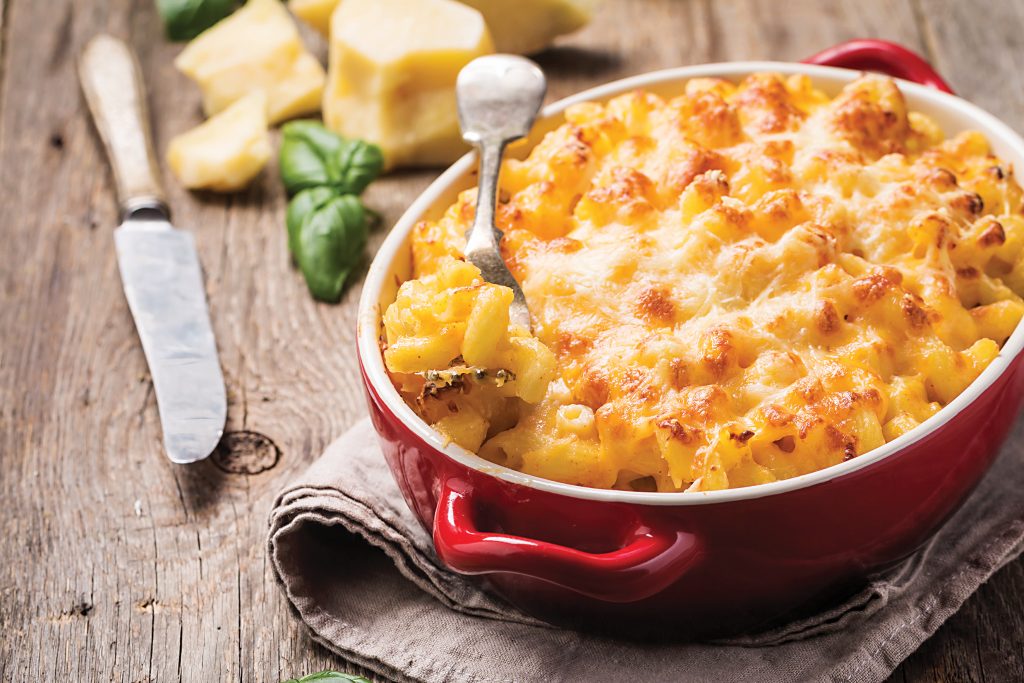
There is nothing specifically “Alabama” about mac and cheese except maybe its ubiquity at eateries around the state ranging from the humble to the fancy and fine. And at every place and in every home, the favored recipe is likely different. It must be cheesy and creamy, of course. But after those requirements, opinions vary on what earns the “best” mac and cheese that superlative. Are only elbows appropriate? Should there be a breadcrumb topping? Is cheddar the preferred cheese? (It begs another question too. Often residing alongside collards, black-eyed-peas and more on “veggies” menus at Alabama meat ‘n threes and barbecue restaurants, is mac and cheese vegetable? Alas, most experts say, no.)
Thomas-McMillan says it’s unfair to relegate mac and cheese — which easily made its way onto her essential dish list — to the side-dish group; she claims it can stand alone as an entrée. “Every Alabamian should know how to make mac and cheese. I am talking about the gooey, creamy, it’s-the-cheesiest mac and cheese. It is such an eye-pleasing, warm, comforting dish, that, by itself, can serve as a meal.” she says. “At Drexell & Honeybees, we make ours with eight different cheeses, and what people love about it is when we dip it up, it fights to stay in the pan with those long silky threads of melted cheese hanging on.”
Fruit Cobbler
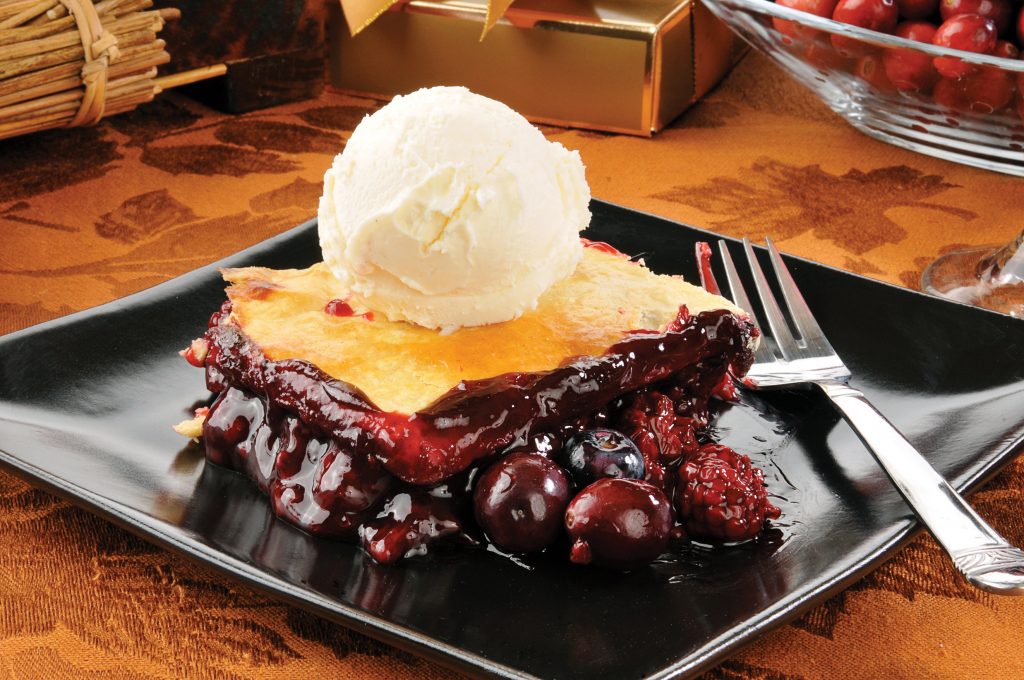
Like West Indies Salad, a fruit cobbler is a simple dish, easy to make and even easier to eat. You can use pretty much any fruit as your filling, but to make it a truly Alabama fruit cobbler, you should opt for either blackberries or peaches. As the state’s official fruit, the blackberry is bona fide. But the peach has equally impressive credentials. It’s the official state tree fruit and is the pride and joy of an entire Alabama county — Chilton — where multiple peach orchards produce the prized blushing orbs.
Blackberry cobbler was first on the essential dishes list of Emily Blejwas. While the director of the Alabama Folklife Association and author of The Story of Alabama in Fourteen Foods has expertise on our state’s foodways, she admitted she doesn’t really cook. And even though she does love to bake, she’s not yet made a blackberry cobbler. But she loves to eat it, and she’s now growing her own blackberries, which she says will one day soon end up in a cobbler. “A couple of years ago, my husband planted a blackberry bush that blasts us with berries early on, then gives a handful every day in August, like a sweet afterthought. I pick them in the evening when I let the chickens out,” she says. “Since I’ve not yet made my own cobbler, I’ll offer my friend Meredith’s mother’s advice: ‘Don’t be scared of it. It’s just biscuits. Just berries and sugar and biscuits.’ Pretty soon I’ll find the courage and make one.”
Carlton had cobbler among his picks too, but he is team peach. “Since Alabama is blessed with the sweetest, juiciest most delicious peaches on the planet — God bless you, Chilton County! — it would be a crying shame if you didn’t have a homemade peach pie or cobbler in your recipe repertoire,” he says.
Honorable Mention: Peanut Butter Pie
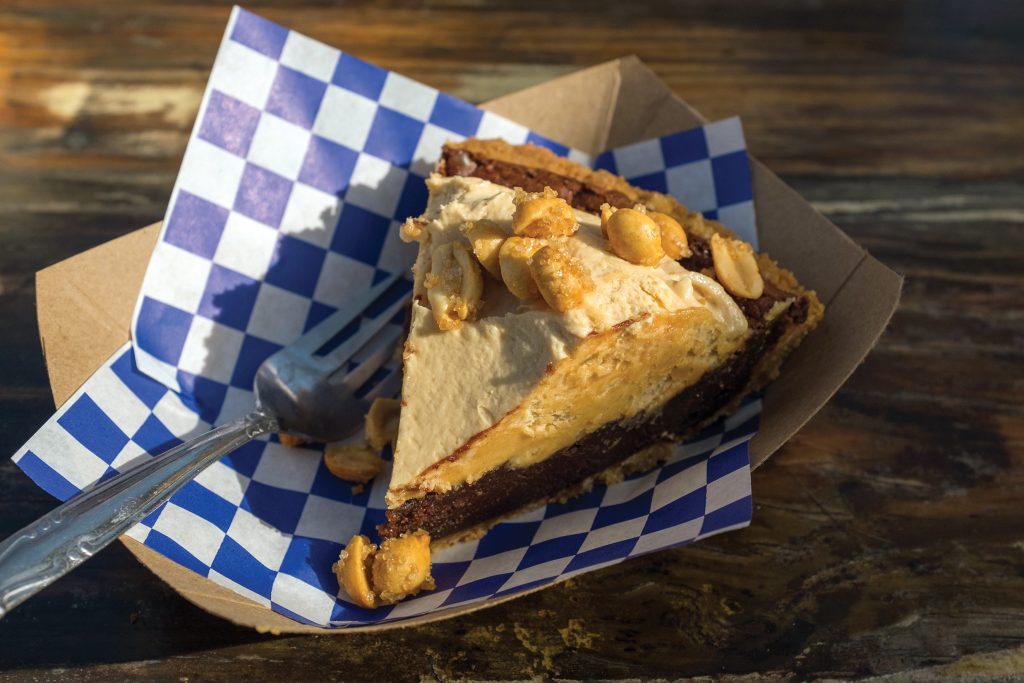
Emily Blejwas knows as much about Alabama’s food culture, particularly its history, as just about anyone, and she argued that peanut butter pie deserves a place on the essential dishes list, not for the pie part, but for the peanut and its association with an Alabama VIP – the brilliant and trail-blazing scientist George Washington Carver.
While head of Tuskegee Institute’s agricultural school, Carver made massive contributions to the crucial industry, inventing hundreds of uses for common crops like sweet potatoes and soybeans and of course, peanuts. “I love this dessert because George Washington Carver is my all-time hero, and everything peanut reminds me of him,” Blejwas says. “I visited Carver’s birthplace in Missouri this summer, and it was the most hallowed ground I’ve ever walked.”




